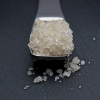horned lark
A small songbird common to fields, deserts, and tundra with a high, tinkling song that can tumble down from heights and flights hundreds of feet in the air. Their diet consists of seeds and insects and, although common throughout North America, their numbers have declined in the last fifty years. Their name comes from the black head striped that occasionally raises into tufted "horns" atop their heads.










